FedEx Corporation: Transportation and Distribution Management Report
VerifiedAdded on 2023/05/31
|13
|3083
|202
Report
AI Summary
This report offers a comprehensive analysis of transportation and distribution management within FedEx Corporation. It begins with an introduction to transportation management systems and distribution management, highlighting their significance within the supply chain. The report then delves into three key aspects: the selection of appropriate Incoterms for FedEx, recommending DAT and DAP; the criteria for effective carrier selection, emphasizing factors like on-time delivery, customer service, safety, financial stability, and references; and carrier relationship management, advocating for a two-way partnership built on respect, empathy, and clear expectations. Recommendations are provided throughout, including a focus on building strong, win-win relationships with carriers and treating them professionally. The report concludes by emphasizing the importance of these strategies for FedEx to achieve its objectives in a competitive global market, highlighting the need for adaptability and a focus on customer service.
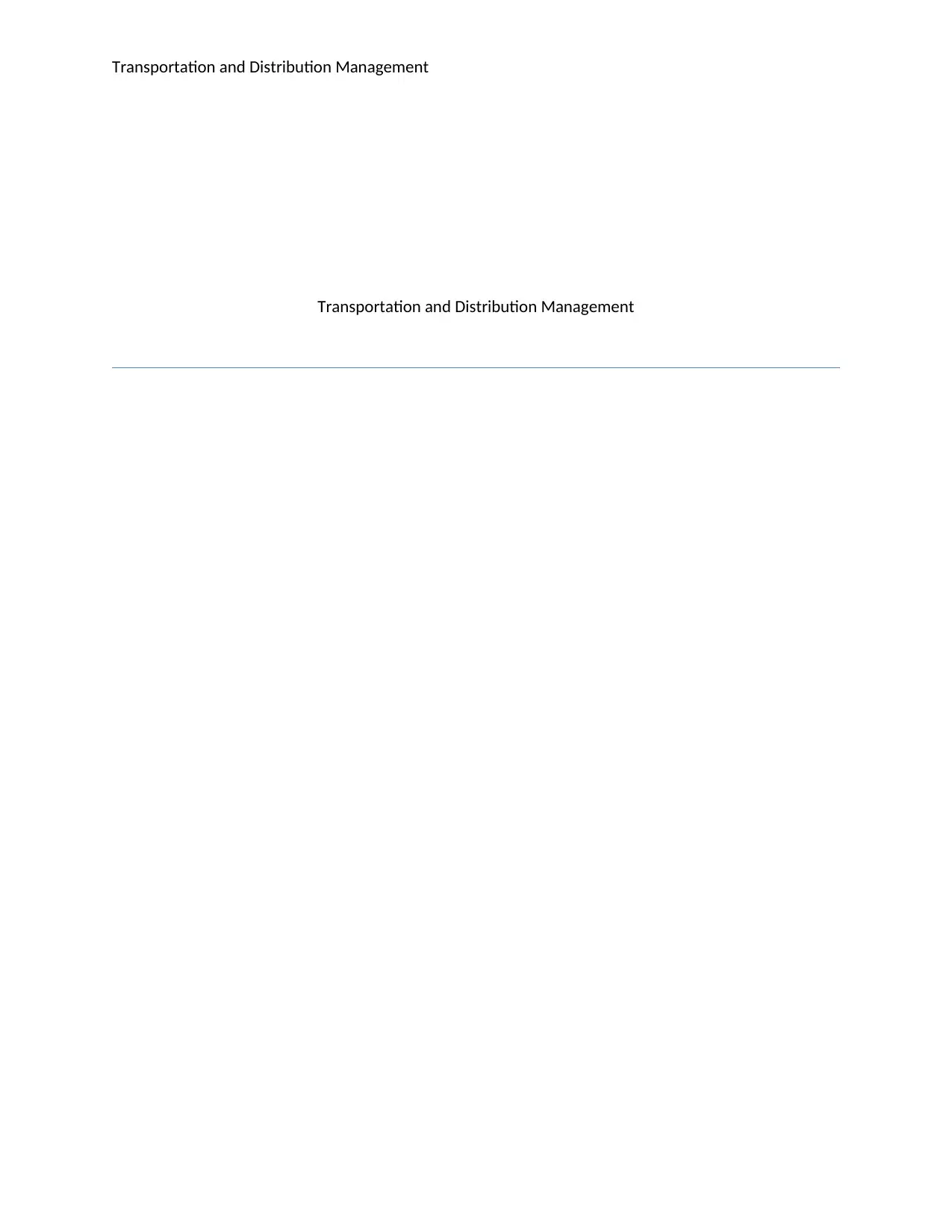
Transportation and Distribution Management
Transportation and Distribution Management
Transportation and Distribution Management
Paraphrase This Document
Need a fresh take? Get an instant paraphrase of this document with our AI Paraphraser

Transportation and Distribution Management 1
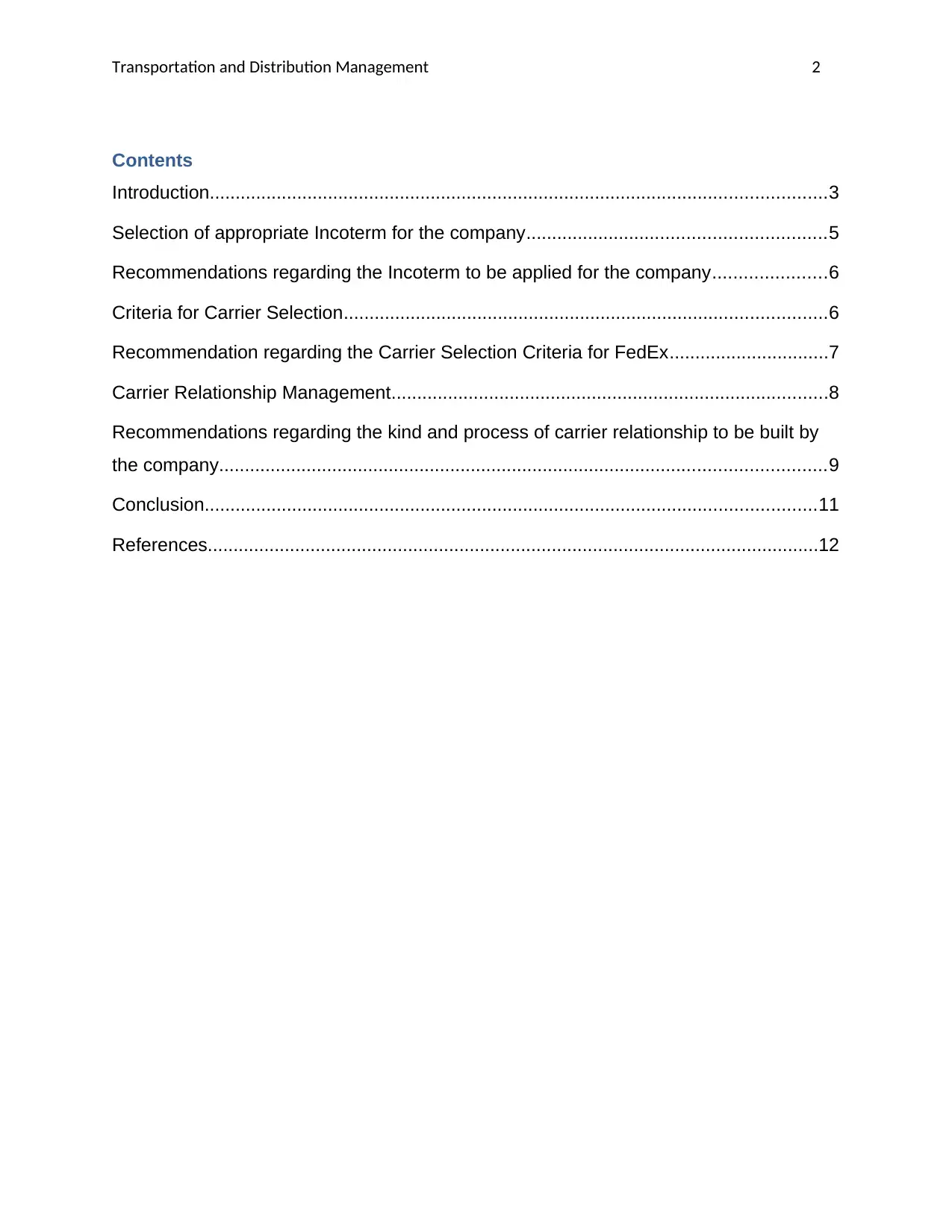
Transportation and Distribution Management 2
Contents
Introduction........................................................................................................................3
Selection of appropriate Incoterm for the company..........................................................5
Recommendations regarding the Incoterm to be applied for the company......................6
Criteria for Carrier Selection..............................................................................................6
Recommendation regarding the Carrier Selection Criteria for FedEx...............................7
Carrier Relationship Management.....................................................................................8
Recommendations regarding the kind and process of carrier relationship to be built by
the company......................................................................................................................9
Conclusion.......................................................................................................................11
References.......................................................................................................................12
Contents
Introduction........................................................................................................................3
Selection of appropriate Incoterm for the company..........................................................5
Recommendations regarding the Incoterm to be applied for the company......................6
Criteria for Carrier Selection..............................................................................................6
Recommendation regarding the Carrier Selection Criteria for FedEx...............................7
Carrier Relationship Management.....................................................................................8
Recommendations regarding the kind and process of carrier relationship to be built by
the company......................................................................................................................9
Conclusion.......................................................................................................................11
References.......................................................................................................................12
⊘ This is a preview!⊘
Do you want full access?
Subscribe today to unlock all pages.

Trusted by 1+ million students worldwide
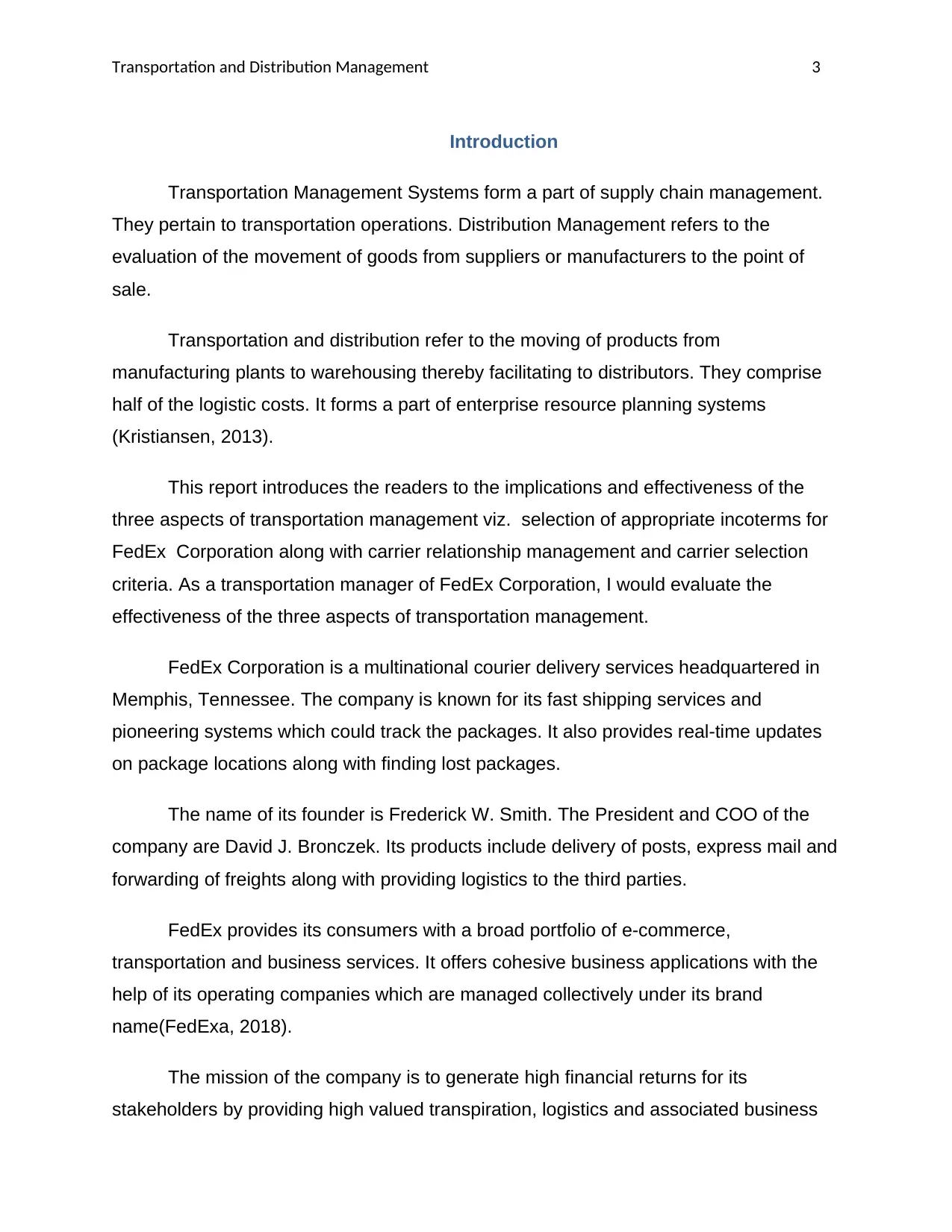
Transportation and Distribution Management 3
Introduction
Transportation Management Systems form a part of supply chain management.
They pertain to transportation operations. Distribution Management refers to the
evaluation of the movement of goods from suppliers or manufacturers to the point of
sale.
Transportation and distribution refer to the moving of products from
manufacturing plants to warehousing thereby facilitating to distributors. They comprise
half of the logistic costs. It forms a part of enterprise resource planning systems
(Kristiansen, 2013).
This report introduces the readers to the implications and effectiveness of the
three aspects of transportation management viz. selection of appropriate incoterms for
FedEx Corporation along with carrier relationship management and carrier selection
criteria. As a transportation manager of FedEx Corporation, I would evaluate the
effectiveness of the three aspects of transportation management.
FedEx Corporation is a multinational courier delivery services headquartered in
Memphis, Tennessee. The company is known for its fast shipping services and
pioneering systems which could track the packages. It also provides real-time updates
on package locations along with finding lost packages.
The name of its founder is Frederick W. Smith. The President and COO of the
company are David J. Bronczek. Its products include delivery of posts, express mail and
forwarding of freights along with providing logistics to the third parties.
FedEx provides its consumers with a broad portfolio of e-commerce,
transportation and business services. It offers cohesive business applications with the
help of its operating companies which are managed collectively under its brand
name(FedExa, 2018).
The mission of the company is to generate high financial returns for its
stakeholders by providing high valued transpiration, logistics and associated business
Introduction
Transportation Management Systems form a part of supply chain management.
They pertain to transportation operations. Distribution Management refers to the
evaluation of the movement of goods from suppliers or manufacturers to the point of
sale.
Transportation and distribution refer to the moving of products from
manufacturing plants to warehousing thereby facilitating to distributors. They comprise
half of the logistic costs. It forms a part of enterprise resource planning systems
(Kristiansen, 2013).
This report introduces the readers to the implications and effectiveness of the
three aspects of transportation management viz. selection of appropriate incoterms for
FedEx Corporation along with carrier relationship management and carrier selection
criteria. As a transportation manager of FedEx Corporation, I would evaluate the
effectiveness of the three aspects of transportation management.
FedEx Corporation is a multinational courier delivery services headquartered in
Memphis, Tennessee. The company is known for its fast shipping services and
pioneering systems which could track the packages. It also provides real-time updates
on package locations along with finding lost packages.
The name of its founder is Frederick W. Smith. The President and COO of the
company are David J. Bronczek. Its products include delivery of posts, express mail and
forwarding of freights along with providing logistics to the third parties.
FedEx provides its consumers with a broad portfolio of e-commerce,
transportation and business services. It offers cohesive business applications with the
help of its operating companies which are managed collectively under its brand
name(FedExa, 2018).
The mission of the company is to generate high financial returns for its
stakeholders by providing high valued transpiration, logistics and associated business
Paraphrase This Document
Need a fresh take? Get an instant paraphrase of this document with our AI Paraphraser
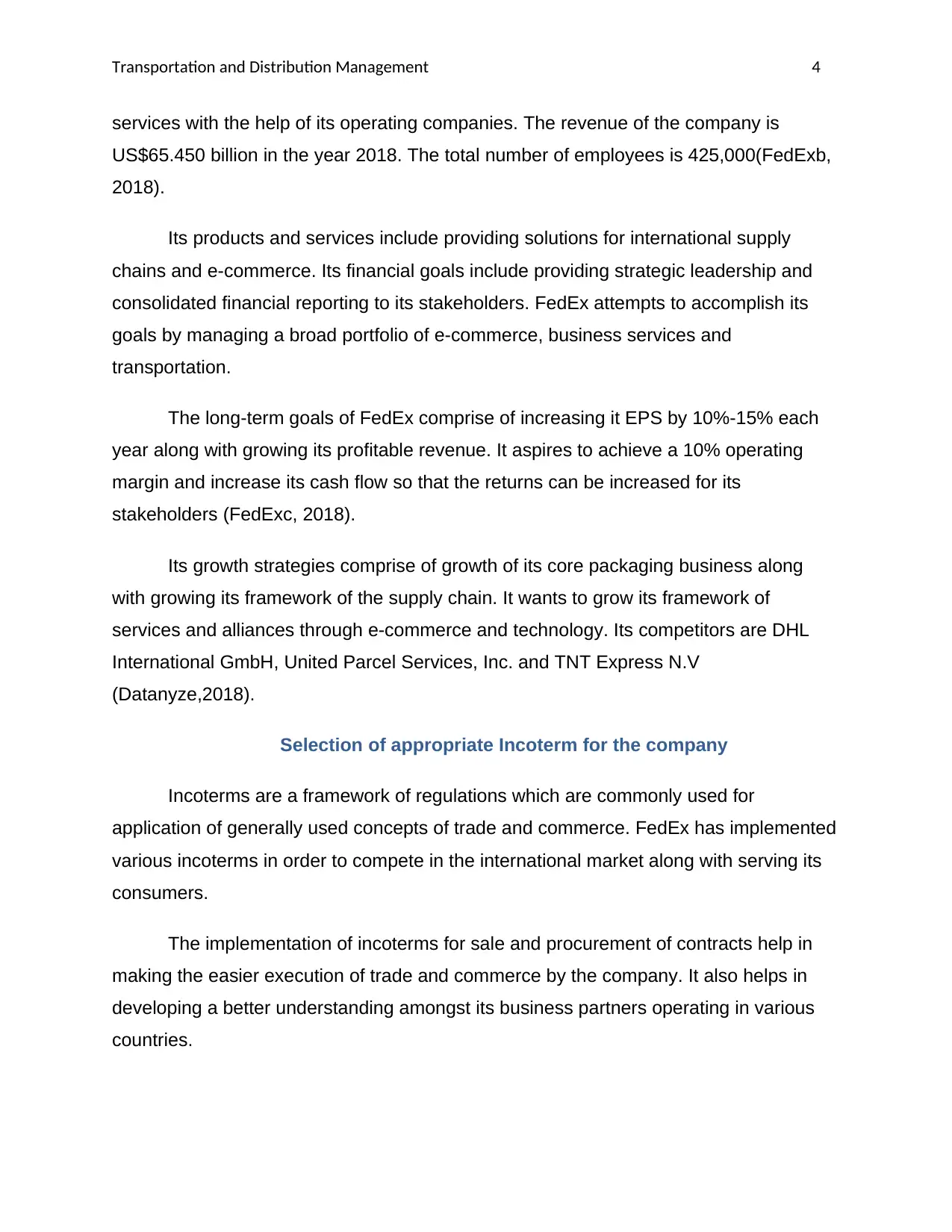
Transportation and Distribution Management 4
services with the help of its operating companies. The revenue of the company is
US$65.450 billion in the year 2018. The total number of employees is 425,000(FedExb,
2018).
Its products and services include providing solutions for international supply
chains and e-commerce. Its financial goals include providing strategic leadership and
consolidated financial reporting to its stakeholders. FedEx attempts to accomplish its
goals by managing a broad portfolio of e-commerce, business services and
transportation.
The long-term goals of FedEx comprise of increasing it EPS by 10%-15% each
year along with growing its profitable revenue. It aspires to achieve a 10% operating
margin and increase its cash flow so that the returns can be increased for its
stakeholders (FedExc, 2018).
Its growth strategies comprise of growth of its core packaging business along
with growing its framework of the supply chain. It wants to grow its framework of
services and alliances through e-commerce and technology. Its competitors are DHL
International GmbH, United Parcel Services, Inc. and TNT Express N.V
(Datanyze,2018).
Selection of appropriate Incoterm for the company
Incoterms are a framework of regulations which are commonly used for
application of generally used concepts of trade and commerce. FedEx has implemented
various incoterms in order to compete in the international market along with serving its
consumers.
The implementation of incoterms for sale and procurement of contracts help in
making the easier execution of trade and commerce by the company. It also helps in
developing a better understanding amongst its business partners operating in various
countries.
services with the help of its operating companies. The revenue of the company is
US$65.450 billion in the year 2018. The total number of employees is 425,000(FedExb,
2018).
Its products and services include providing solutions for international supply
chains and e-commerce. Its financial goals include providing strategic leadership and
consolidated financial reporting to its stakeholders. FedEx attempts to accomplish its
goals by managing a broad portfolio of e-commerce, business services and
transportation.
The long-term goals of FedEx comprise of increasing it EPS by 10%-15% each
year along with growing its profitable revenue. It aspires to achieve a 10% operating
margin and increase its cash flow so that the returns can be increased for its
stakeholders (FedExc, 2018).
Its growth strategies comprise of growth of its core packaging business along
with growing its framework of the supply chain. It wants to grow its framework of
services and alliances through e-commerce and technology. Its competitors are DHL
International GmbH, United Parcel Services, Inc. and TNT Express N.V
(Datanyze,2018).
Selection of appropriate Incoterm for the company
Incoterms are a framework of regulations which are commonly used for
application of generally used concepts of trade and commerce. FedEx has implemented
various incoterms in order to compete in the international market along with serving its
consumers.
The implementation of incoterms for sale and procurement of contracts help in
making the easier execution of trade and commerce by the company. It also helps in
developing a better understanding amongst its business partners operating in various
countries.
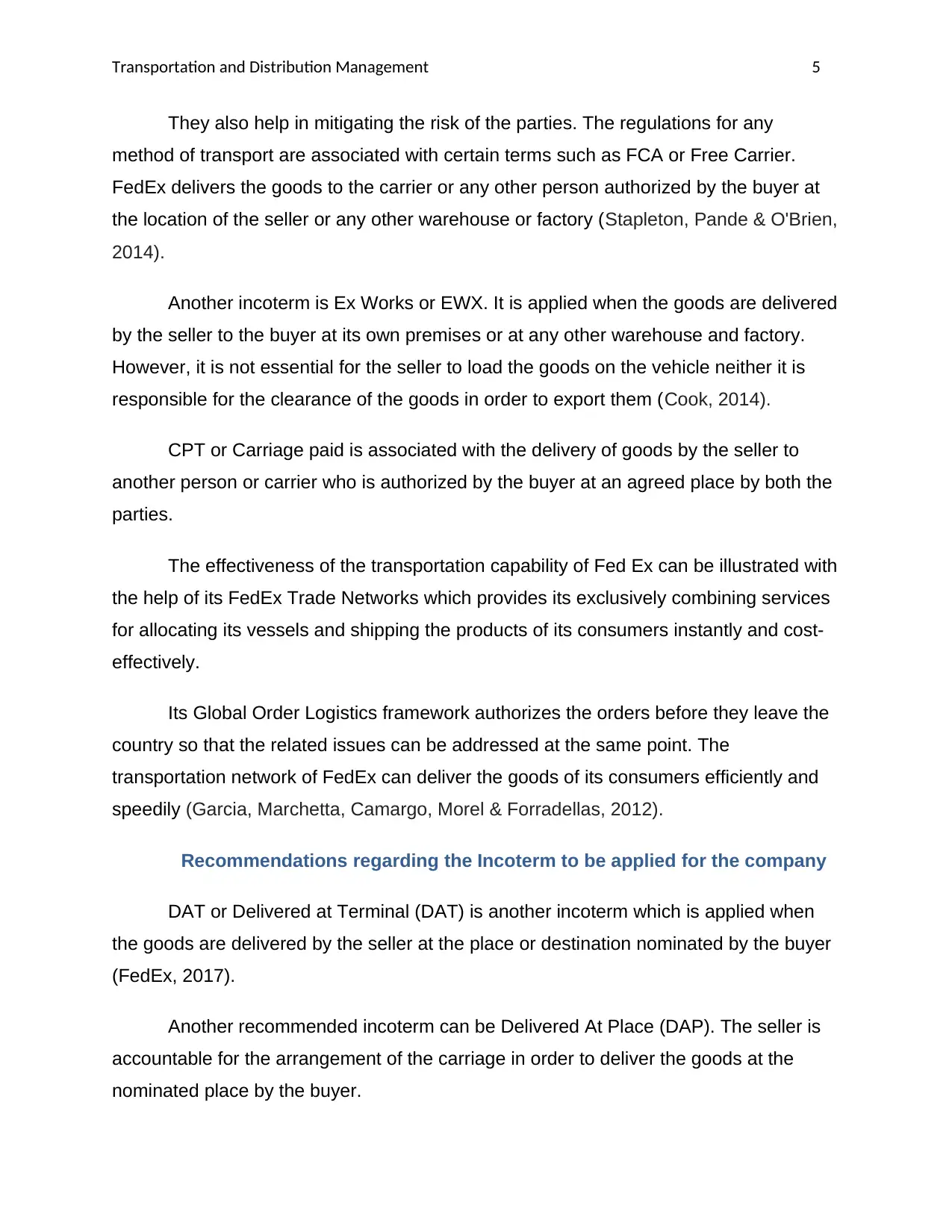
Transportation and Distribution Management 5
They also help in mitigating the risk of the parties. The regulations for any
method of transport are associated with certain terms such as FCA or Free Carrier.
FedEx delivers the goods to the carrier or any other person authorized by the buyer at
the location of the seller or any other warehouse or factory (Stapleton, Pande & O'Brien,
2014).
Another incoterm is Ex Works or EWX. It is applied when the goods are delivered
by the seller to the buyer at its own premises or at any other warehouse and factory.
However, it is not essential for the seller to load the goods on the vehicle neither it is
responsible for the clearance of the goods in order to export them (Cook, 2014).
CPT or Carriage paid is associated with the delivery of goods by the seller to
another person or carrier who is authorized by the buyer at an agreed place by both the
parties.
The effectiveness of the transportation capability of Fed Ex can be illustrated with
the help of its FedEx Trade Networks which provides its exclusively combining services
for allocating its vessels and shipping the products of its consumers instantly and cost-
effectively.
Its Global Order Logistics framework authorizes the orders before they leave the
country so that the related issues can be addressed at the same point. The
transportation network of FedEx can deliver the goods of its consumers efficiently and
speedily (Garcia, Marchetta, Camargo, Morel & Forradellas, 2012).
Recommendations regarding the Incoterm to be applied for the company
DAT or Delivered at Terminal (DAT) is another incoterm which is applied when
the goods are delivered by the seller at the place or destination nominated by the buyer
(FedEx, 2017).
Another recommended incoterm can be Delivered At Place (DAP). The seller is
accountable for the arrangement of the carriage in order to deliver the goods at the
nominated place by the buyer.
They also help in mitigating the risk of the parties. The regulations for any
method of transport are associated with certain terms such as FCA or Free Carrier.
FedEx delivers the goods to the carrier or any other person authorized by the buyer at
the location of the seller or any other warehouse or factory (Stapleton, Pande & O'Brien,
2014).
Another incoterm is Ex Works or EWX. It is applied when the goods are delivered
by the seller to the buyer at its own premises or at any other warehouse and factory.
However, it is not essential for the seller to load the goods on the vehicle neither it is
responsible for the clearance of the goods in order to export them (Cook, 2014).
CPT or Carriage paid is associated with the delivery of goods by the seller to
another person or carrier who is authorized by the buyer at an agreed place by both the
parties.
The effectiveness of the transportation capability of Fed Ex can be illustrated with
the help of its FedEx Trade Networks which provides its exclusively combining services
for allocating its vessels and shipping the products of its consumers instantly and cost-
effectively.
Its Global Order Logistics framework authorizes the orders before they leave the
country so that the related issues can be addressed at the same point. The
transportation network of FedEx can deliver the goods of its consumers efficiently and
speedily (Garcia, Marchetta, Camargo, Morel & Forradellas, 2012).
Recommendations regarding the Incoterm to be applied for the company
DAT or Delivered at Terminal (DAT) is another incoterm which is applied when
the goods are delivered by the seller at the place or destination nominated by the buyer
(FedEx, 2017).
Another recommended incoterm can be Delivered At Place (DAP). The seller is
accountable for the arrangement of the carriage in order to deliver the goods at the
nominated place by the buyer.
⊘ This is a preview!⊘
Do you want full access?
Subscribe today to unlock all pages.

Trusted by 1+ million students worldwide

Transportation and Distribution Management 6
Criteria for Carrier Selection
FedEx aspires to be amongst the top logistics companies all over the world. It
intends for its business expansion beyond its current operations in 220 countries. FedEx
aspires to develop its abilities in order to provide a wide range of services to its
consumers.
It offers various logistic solutions which range from its critical express deliveries
to the transportation of freight. Its transportation management system helps in saving
the effort of its clients. It provides flexible business services to its clients through which
they can develop their own transportation management systems( Marchet, Melacini &
Perotti,2014 ).
FedEx manages all the inbound and outbound transportation systems of its
clients. It also provides more time-definite options for its clients. It customizes the
truckloads delivery commitments if its clients with its definite 60 and definite 15 options
(da Mota Pedrosa, Näslund & Jasmand, 2012).
In order to accomplish the goals of the company, it should search for a logistics
provider which must be competent to meet its transportation needs. In this context, it is
mandatory to evaluate if it can assist the company to meet its long-term and short-term
goals.
Recommendation regarding the Carrier Selection Criteria for FedEx
While assessing the carrier, FedEx must enquire about the repetitiveness of the
truck lanes. It should also be evaluated if they originate from a limited number of
shipping points and terminate a limited number of consignees.
It should also be enquired about the on-time delivery of shipments. In this
context, the mid-sized asset-based carrier would meet all the requirements without
getting distracted by the large list of its clients. It should also be evaluated that whether
the carrier prioritizes the customer services and is promptly responsive to the queries of
its clients.
Criteria for Carrier Selection
FedEx aspires to be amongst the top logistics companies all over the world. It
intends for its business expansion beyond its current operations in 220 countries. FedEx
aspires to develop its abilities in order to provide a wide range of services to its
consumers.
It offers various logistic solutions which range from its critical express deliveries
to the transportation of freight. Its transportation management system helps in saving
the effort of its clients. It provides flexible business services to its clients through which
they can develop their own transportation management systems( Marchet, Melacini &
Perotti,2014 ).
FedEx manages all the inbound and outbound transportation systems of its
clients. It also provides more time-definite options for its clients. It customizes the
truckloads delivery commitments if its clients with its definite 60 and definite 15 options
(da Mota Pedrosa, Näslund & Jasmand, 2012).
In order to accomplish the goals of the company, it should search for a logistics
provider which must be competent to meet its transportation needs. In this context, it is
mandatory to evaluate if it can assist the company to meet its long-term and short-term
goals.
Recommendation regarding the Carrier Selection Criteria for FedEx
While assessing the carrier, FedEx must enquire about the repetitiveness of the
truck lanes. It should also be evaluated if they originate from a limited number of
shipping points and terminate a limited number of consignees.
It should also be enquired about the on-time delivery of shipments. In this
context, the mid-sized asset-based carrier would meet all the requirements without
getting distracted by the large list of its clients. It should also be evaluated that whether
the carrier prioritizes the customer services and is promptly responsive to the queries of
its clients.
Paraphrase This Document
Need a fresh take? Get an instant paraphrase of this document with our AI Paraphraser
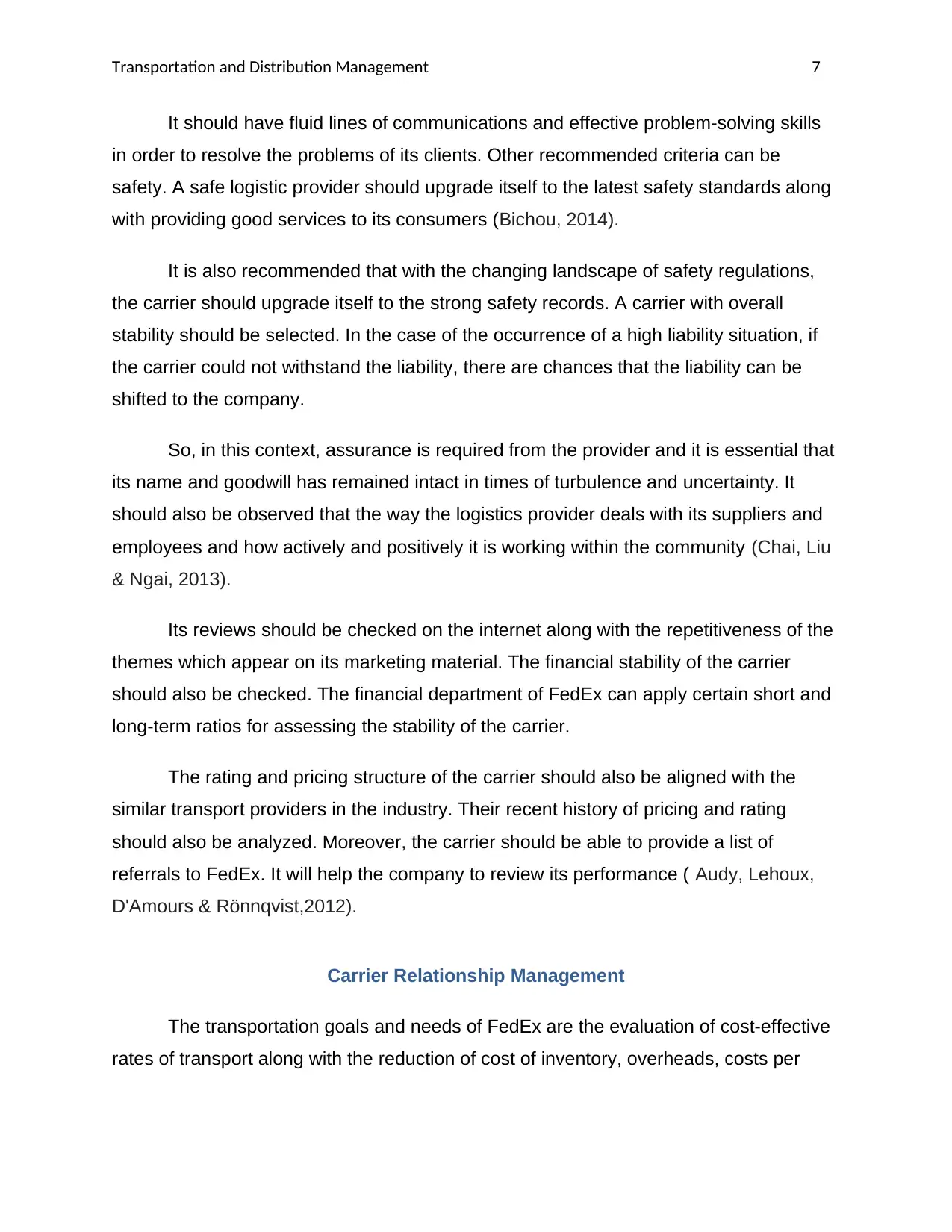
Transportation and Distribution Management 7
It should have fluid lines of communications and effective problem-solving skills
in order to resolve the problems of its clients. Other recommended criteria can be
safety. A safe logistic provider should upgrade itself to the latest safety standards along
with providing good services to its consumers (Bichou, 2014).
It is also recommended that with the changing landscape of safety regulations,
the carrier should upgrade itself to the strong safety records. A carrier with overall
stability should be selected. In the case of the occurrence of a high liability situation, if
the carrier could not withstand the liability, there are chances that the liability can be
shifted to the company.
So, in this context, assurance is required from the provider and it is essential that
its name and goodwill has remained intact in times of turbulence and uncertainty. It
should also be observed that the way the logistics provider deals with its suppliers and
employees and how actively and positively it is working within the community (Chai, Liu
& Ngai, 2013).
Its reviews should be checked on the internet along with the repetitiveness of the
themes which appear on its marketing material. The financial stability of the carrier
should also be checked. The financial department of FedEx can apply certain short and
long-term ratios for assessing the stability of the carrier.
The rating and pricing structure of the carrier should also be aligned with the
similar transport providers in the industry. Their recent history of pricing and rating
should also be analyzed. Moreover, the carrier should be able to provide a list of
referrals to FedEx. It will help the company to review its performance ( Audy, Lehoux,
D'Amours & Rönnqvist,2012).
Carrier Relationship Management
The transportation goals and needs of FedEx are the evaluation of cost-effective
rates of transport along with the reduction of cost of inventory, overheads, costs per
It should have fluid lines of communications and effective problem-solving skills
in order to resolve the problems of its clients. Other recommended criteria can be
safety. A safe logistic provider should upgrade itself to the latest safety standards along
with providing good services to its consumers (Bichou, 2014).
It is also recommended that with the changing landscape of safety regulations,
the carrier should upgrade itself to the strong safety records. A carrier with overall
stability should be selected. In the case of the occurrence of a high liability situation, if
the carrier could not withstand the liability, there are chances that the liability can be
shifted to the company.
So, in this context, assurance is required from the provider and it is essential that
its name and goodwill has remained intact in times of turbulence and uncertainty. It
should also be observed that the way the logistics provider deals with its suppliers and
employees and how actively and positively it is working within the community (Chai, Liu
& Ngai, 2013).
Its reviews should be checked on the internet along with the repetitiveness of the
themes which appear on its marketing material. The financial stability of the carrier
should also be checked. The financial department of FedEx can apply certain short and
long-term ratios for assessing the stability of the carrier.
The rating and pricing structure of the carrier should also be aligned with the
similar transport providers in the industry. Their recent history of pricing and rating
should also be analyzed. Moreover, the carrier should be able to provide a list of
referrals to FedEx. It will help the company to review its performance ( Audy, Lehoux,
D'Amours & Rönnqvist,2012).
Carrier Relationship Management
The transportation goals and needs of FedEx are the evaluation of cost-effective
rates of transport along with the reduction of cost of inventory, overheads, costs per
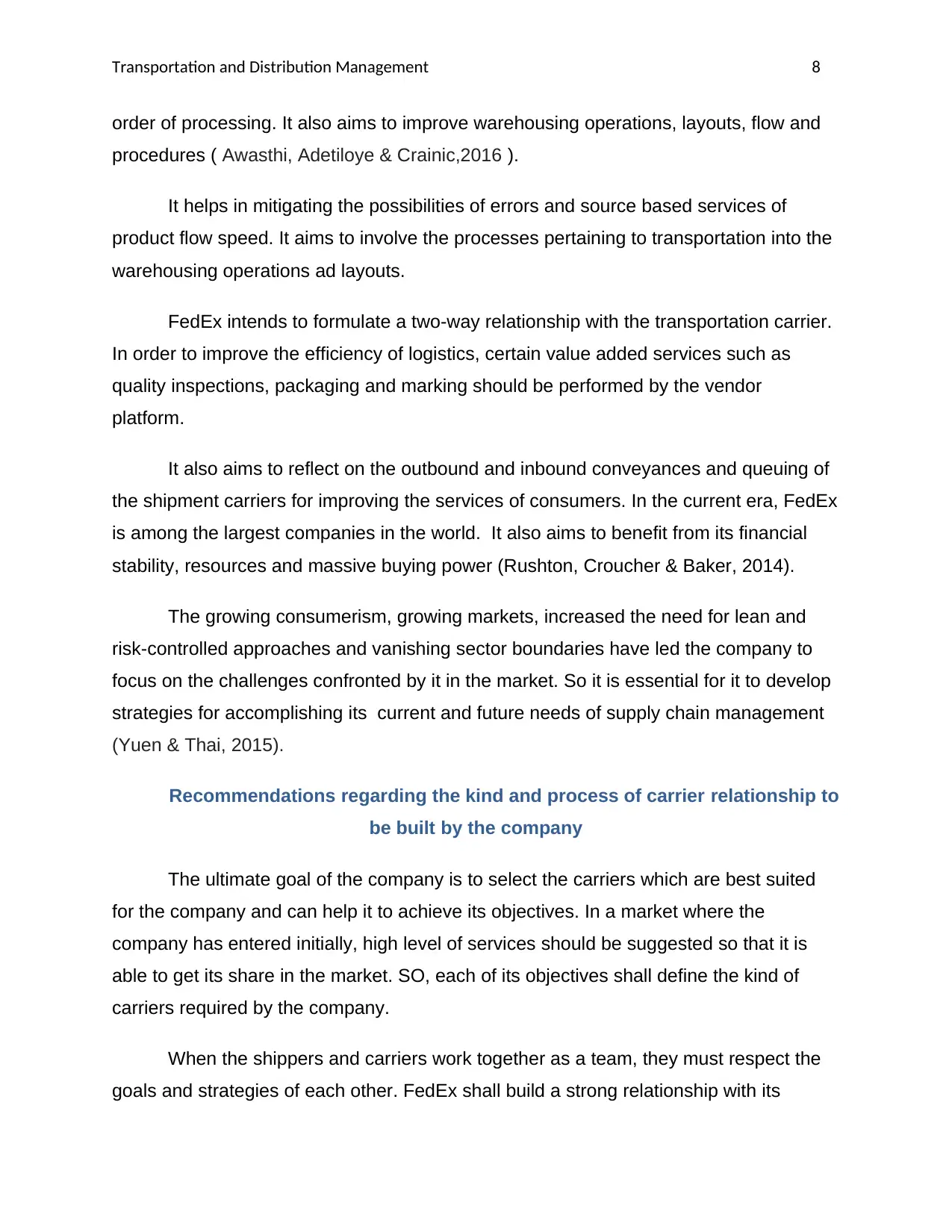
Transportation and Distribution Management 8
order of processing. It also aims to improve warehousing operations, layouts, flow and
procedures ( Awasthi, Adetiloye & Crainic,2016 ).
It helps in mitigating the possibilities of errors and source based services of
product flow speed. It aims to involve the processes pertaining to transportation into the
warehousing operations ad layouts.
FedEx intends to formulate a two-way relationship with the transportation carrier.
In order to improve the efficiency of logistics, certain value added services such as
quality inspections, packaging and marking should be performed by the vendor
platform.
It also aims to reflect on the outbound and inbound conveyances and queuing of
the shipment carriers for improving the services of consumers. In the current era, FedEx
is among the largest companies in the world. It also aims to benefit from its financial
stability, resources and massive buying power (Rushton, Croucher & Baker, 2014).
The growing consumerism, growing markets, increased the need for lean and
risk-controlled approaches and vanishing sector boundaries have led the company to
focus on the challenges confronted by it in the market. So it is essential for it to develop
strategies for accomplishing its current and future needs of supply chain management
(Yuen & Thai, 2015).
Recommendations regarding the kind and process of carrier relationship to
be built by the company
The ultimate goal of the company is to select the carriers which are best suited
for the company and can help it to achieve its objectives. In a market where the
company has entered initially, high level of services should be suggested so that it is
able to get its share in the market. SO, each of its objectives shall define the kind of
carriers required by the company.
When the shippers and carriers work together as a team, they must respect the
goals and strategies of each other. FedEx shall build a strong relationship with its
order of processing. It also aims to improve warehousing operations, layouts, flow and
procedures ( Awasthi, Adetiloye & Crainic,2016 ).
It helps in mitigating the possibilities of errors and source based services of
product flow speed. It aims to involve the processes pertaining to transportation into the
warehousing operations ad layouts.
FedEx intends to formulate a two-way relationship with the transportation carrier.
In order to improve the efficiency of logistics, certain value added services such as
quality inspections, packaging and marking should be performed by the vendor
platform.
It also aims to reflect on the outbound and inbound conveyances and queuing of
the shipment carriers for improving the services of consumers. In the current era, FedEx
is among the largest companies in the world. It also aims to benefit from its financial
stability, resources and massive buying power (Rushton, Croucher & Baker, 2014).
The growing consumerism, growing markets, increased the need for lean and
risk-controlled approaches and vanishing sector boundaries have led the company to
focus on the challenges confronted by it in the market. So it is essential for it to develop
strategies for accomplishing its current and future needs of supply chain management
(Yuen & Thai, 2015).
Recommendations regarding the kind and process of carrier relationship to
be built by the company
The ultimate goal of the company is to select the carriers which are best suited
for the company and can help it to achieve its objectives. In a market where the
company has entered initially, high level of services should be suggested so that it is
able to get its share in the market. SO, each of its objectives shall define the kind of
carriers required by the company.
When the shippers and carriers work together as a team, they must respect the
goals and strategies of each other. FedEx shall build a strong relationship with its
⊘ This is a preview!⊘
Do you want full access?
Subscribe today to unlock all pages.

Trusted by 1+ million students worldwide
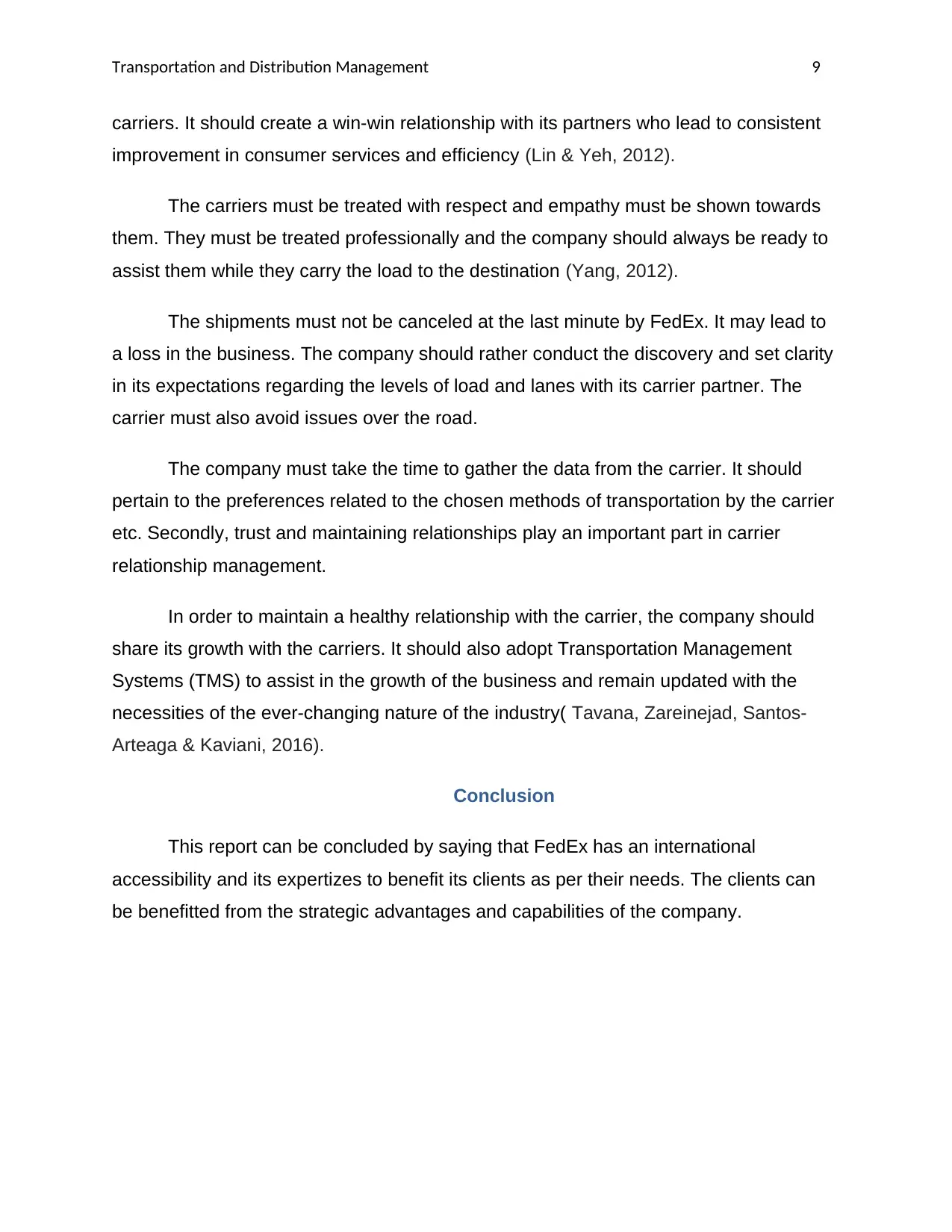
Transportation and Distribution Management 9
carriers. It should create a win-win relationship with its partners who lead to consistent
improvement in consumer services and efficiency (Lin & Yeh, 2012).
The carriers must be treated with respect and empathy must be shown towards
them. They must be treated professionally and the company should always be ready to
assist them while they carry the load to the destination (Yang, 2012).
The shipments must not be canceled at the last minute by FedEx. It may lead to
a loss in the business. The company should rather conduct the discovery and set clarity
in its expectations regarding the levels of load and lanes with its carrier partner. The
carrier must also avoid issues over the road.
The company must take the time to gather the data from the carrier. It should
pertain to the preferences related to the chosen methods of transportation by the carrier
etc. Secondly, trust and maintaining relationships play an important part in carrier
relationship management.
In order to maintain a healthy relationship with the carrier, the company should
share its growth with the carriers. It should also adopt Transportation Management
Systems (TMS) to assist in the growth of the business and remain updated with the
necessities of the ever-changing nature of the industry( Tavana, Zareinejad, Santos-
Arteaga & Kaviani, 2016).
Conclusion
This report can be concluded by saying that FedEx has an international
accessibility and its expertizes to benefit its clients as per their needs. The clients can
be benefitted from the strategic advantages and capabilities of the company.
carriers. It should create a win-win relationship with its partners who lead to consistent
improvement in consumer services and efficiency (Lin & Yeh, 2012).
The carriers must be treated with respect and empathy must be shown towards
them. They must be treated professionally and the company should always be ready to
assist them while they carry the load to the destination (Yang, 2012).
The shipments must not be canceled at the last minute by FedEx. It may lead to
a loss in the business. The company should rather conduct the discovery and set clarity
in its expectations regarding the levels of load and lanes with its carrier partner. The
carrier must also avoid issues over the road.
The company must take the time to gather the data from the carrier. It should
pertain to the preferences related to the chosen methods of transportation by the carrier
etc. Secondly, trust and maintaining relationships play an important part in carrier
relationship management.
In order to maintain a healthy relationship with the carrier, the company should
share its growth with the carriers. It should also adopt Transportation Management
Systems (TMS) to assist in the growth of the business and remain updated with the
necessities of the ever-changing nature of the industry( Tavana, Zareinejad, Santos-
Arteaga & Kaviani, 2016).
Conclusion
This report can be concluded by saying that FedEx has an international
accessibility and its expertizes to benefit its clients as per their needs. The clients can
be benefitted from the strategic advantages and capabilities of the company.
Paraphrase This Document
Need a fresh take? Get an instant paraphrase of this document with our AI Paraphraser
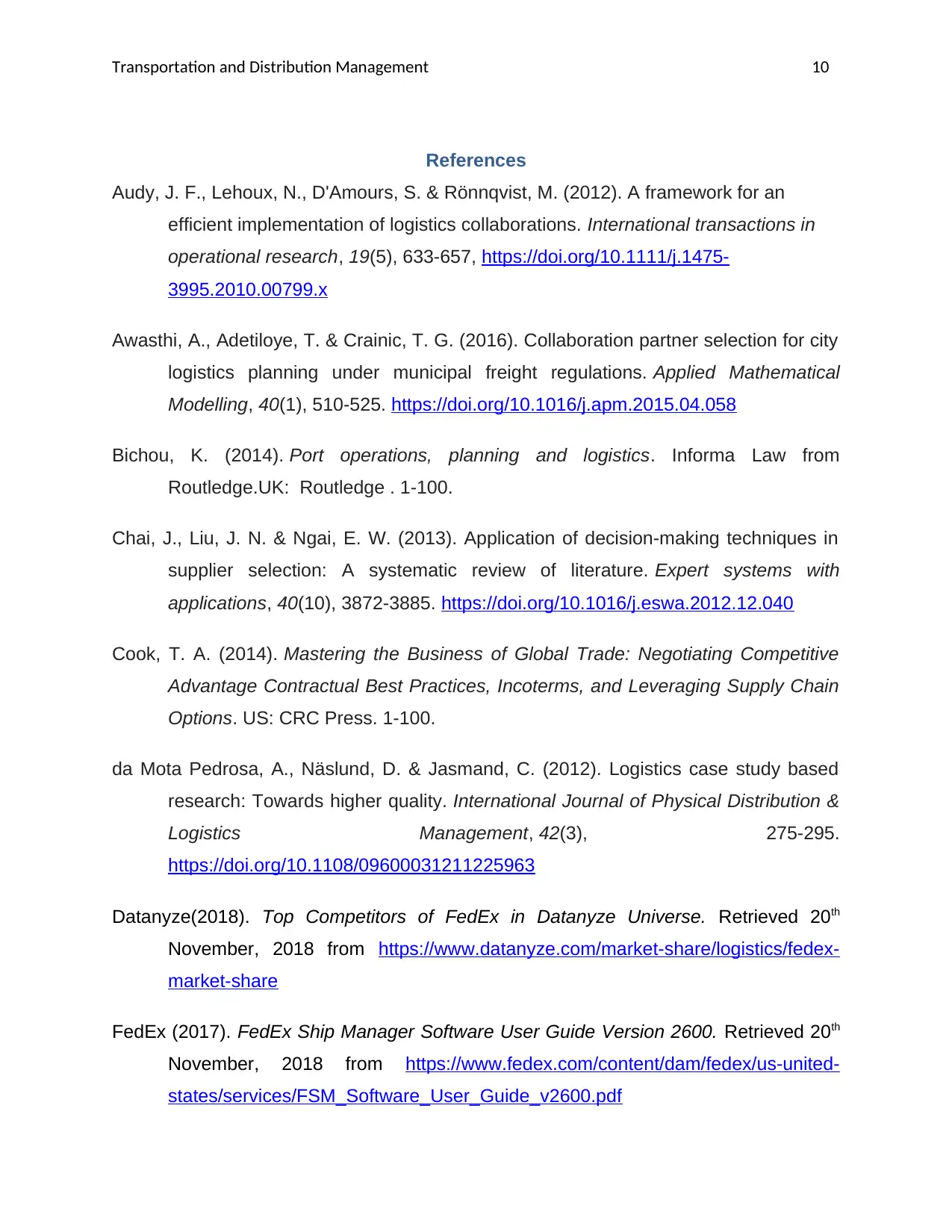
Transportation and Distribution Management 10
References
Audy, J. F., Lehoux, N., D'Amours, S. & Rönnqvist, M. (2012). A framework for an
efficient implementation of logistics collaborations. International transactions in
operational research, 19(5), 633-657, https://doi.org/10.1111/j.1475-
3995.2010.00799.x
Awasthi, A., Adetiloye, T. & Crainic, T. G. (2016). Collaboration partner selection for city
logistics planning under municipal freight regulations. Applied Mathematical
Modelling, 40(1), 510-525. https://doi.org/10.1016/j.apm.2015.04.058
Bichou, K. (2014). Port operations, planning and logistics. Informa Law from
Routledge.UK: Routledge . 1-100.
Chai, J., Liu, J. N. & Ngai, E. W. (2013). Application of decision-making techniques in
supplier selection: A systematic review of literature. Expert systems with
applications, 40(10), 3872-3885. https://doi.org/10.1016/j.eswa.2012.12.040
Cook, T. A. (2014). Mastering the Business of Global Trade: Negotiating Competitive
Advantage Contractual Best Practices, Incoterms, and Leveraging Supply Chain
Options. US: CRC Press. 1-100.
da Mota Pedrosa, A., Näslund, D. & Jasmand, C. (2012). Logistics case study based
research: Towards higher quality. International Journal of Physical Distribution &
Logistics Management, 42(3), 275-295.
https://doi.org/10.1108/09600031211225963
Datanyze(2018). Top Competitors of FedEx in Datanyze Universe. Retrieved 20th
November, 2018 from https://www.datanyze.com/market-share/logistics/fedex-
market-share
FedEx (2017). FedEx Ship Manager Software User Guide Version 2600. Retrieved 20th
November, 2018 from https://www.fedex.com/content/dam/fedex/us-united-
states/services/FSM_Software_User_Guide_v2600.pdf
References
Audy, J. F., Lehoux, N., D'Amours, S. & Rönnqvist, M. (2012). A framework for an
efficient implementation of logistics collaborations. International transactions in
operational research, 19(5), 633-657, https://doi.org/10.1111/j.1475-
3995.2010.00799.x
Awasthi, A., Adetiloye, T. & Crainic, T. G. (2016). Collaboration partner selection for city
logistics planning under municipal freight regulations. Applied Mathematical
Modelling, 40(1), 510-525. https://doi.org/10.1016/j.apm.2015.04.058
Bichou, K. (2014). Port operations, planning and logistics. Informa Law from
Routledge.UK: Routledge . 1-100.
Chai, J., Liu, J. N. & Ngai, E. W. (2013). Application of decision-making techniques in
supplier selection: A systematic review of literature. Expert systems with
applications, 40(10), 3872-3885. https://doi.org/10.1016/j.eswa.2012.12.040
Cook, T. A. (2014). Mastering the Business of Global Trade: Negotiating Competitive
Advantage Contractual Best Practices, Incoterms, and Leveraging Supply Chain
Options. US: CRC Press. 1-100.
da Mota Pedrosa, A., Näslund, D. & Jasmand, C. (2012). Logistics case study based
research: Towards higher quality. International Journal of Physical Distribution &
Logistics Management, 42(3), 275-295.
https://doi.org/10.1108/09600031211225963
Datanyze(2018). Top Competitors of FedEx in Datanyze Universe. Retrieved 20th
November, 2018 from https://www.datanyze.com/market-share/logistics/fedex-
market-share
FedEx (2017). FedEx Ship Manager Software User Guide Version 2600. Retrieved 20th
November, 2018 from https://www.fedex.com/content/dam/fedex/us-united-
states/services/FSM_Software_User_Guide_v2600.pdf
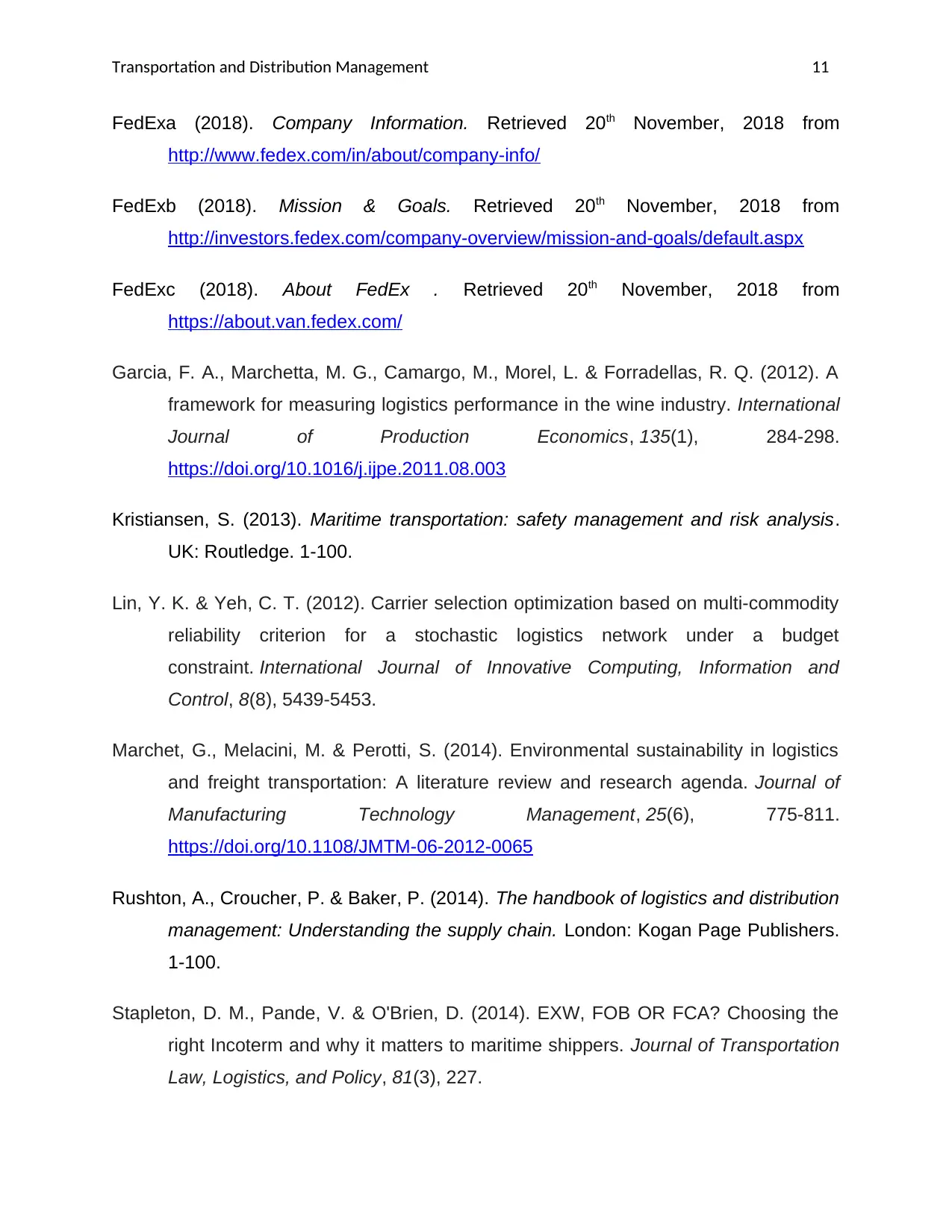
Transportation and Distribution Management 11
FedExa (2018). Company Information. Retrieved 20th November, 2018 from
http://www.fedex.com/in/about/company-info/
FedExb (2018). Mission & Goals. Retrieved 20th November, 2018 from
http://investors.fedex.com/company-overview/mission-and-goals/default.aspx
FedExc (2018). About FedEx . Retrieved 20th November, 2018 from
https://about.van.fedex.com/
Garcia, F. A., Marchetta, M. G., Camargo, M., Morel, L. & Forradellas, R. Q. (2012). A
framework for measuring logistics performance in the wine industry. International
Journal of Production Economics, 135(1), 284-298.
https://doi.org/10.1016/j.ijpe.2011.08.003
Kristiansen, S. (2013). Maritime transportation: safety management and risk analysis.
UK: Routledge. 1-100.
Lin, Y. K. & Yeh, C. T. (2012). Carrier selection optimization based on multi-commodity
reliability criterion for a stochastic logistics network under a budget
constraint. International Journal of Innovative Computing, Information and
Control, 8(8), 5439-5453.
Marchet, G., Melacini, M. & Perotti, S. (2014). Environmental sustainability in logistics
and freight transportation: A literature review and research agenda. Journal of
Manufacturing Technology Management, 25(6), 775-811.
https://doi.org/10.1108/JMTM-06-2012-0065
Rushton, A., Croucher, P. & Baker, P. (2014). The handbook of logistics and distribution
management: Understanding the supply chain. London: Kogan Page Publishers.
1-100.
Stapleton, D. M., Pande, V. & O'Brien, D. (2014). EXW, FOB OR FCA? Choosing the
right Incoterm and why it matters to maritime shippers. Journal of Transportation
Law, Logistics, and Policy, 81(3), 227.
FedExa (2018). Company Information. Retrieved 20th November, 2018 from
http://www.fedex.com/in/about/company-info/
FedExb (2018). Mission & Goals. Retrieved 20th November, 2018 from
http://investors.fedex.com/company-overview/mission-and-goals/default.aspx
FedExc (2018). About FedEx . Retrieved 20th November, 2018 from
https://about.van.fedex.com/
Garcia, F. A., Marchetta, M. G., Camargo, M., Morel, L. & Forradellas, R. Q. (2012). A
framework for measuring logistics performance in the wine industry. International
Journal of Production Economics, 135(1), 284-298.
https://doi.org/10.1016/j.ijpe.2011.08.003
Kristiansen, S. (2013). Maritime transportation: safety management and risk analysis.
UK: Routledge. 1-100.
Lin, Y. K. & Yeh, C. T. (2012). Carrier selection optimization based on multi-commodity
reliability criterion for a stochastic logistics network under a budget
constraint. International Journal of Innovative Computing, Information and
Control, 8(8), 5439-5453.
Marchet, G., Melacini, M. & Perotti, S. (2014). Environmental sustainability in logistics
and freight transportation: A literature review and research agenda. Journal of
Manufacturing Technology Management, 25(6), 775-811.
https://doi.org/10.1108/JMTM-06-2012-0065
Rushton, A., Croucher, P. & Baker, P. (2014). The handbook of logistics and distribution
management: Understanding the supply chain. London: Kogan Page Publishers.
1-100.
Stapleton, D. M., Pande, V. & O'Brien, D. (2014). EXW, FOB OR FCA? Choosing the
right Incoterm and why it matters to maritime shippers. Journal of Transportation
Law, Logistics, and Policy, 81(3), 227.
⊘ This is a preview!⊘
Do you want full access?
Subscribe today to unlock all pages.

Trusted by 1+ million students worldwide
1 out of 13
Related Documents
Your All-in-One AI-Powered Toolkit for Academic Success.
+13062052269
info@desklib.com
Available 24*7 on WhatsApp / Email
![[object Object]](/_next/static/media/star-bottom.7253800d.svg)
Unlock your academic potential
Copyright © 2020–2025 A2Z Services. All Rights Reserved. Developed and managed by ZUCOL.





